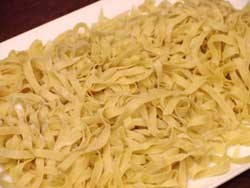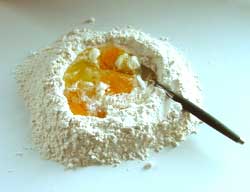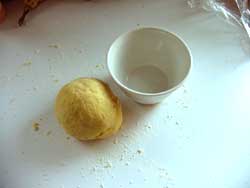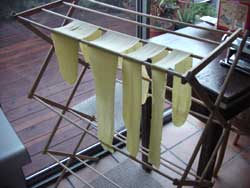
| HOME | > | BASICS |
MAKING EGG PASTA AT HOME
Pasta all'uovo fatta in casaPreparation - Medium
Prep: 1 hour 30 min - Cook: 10 min - Total: 1 hour 30 min
Yield: Serves 4
Sounds daunting, but is actually fairly easy, and certainly rewarding. Homemade pasta has its own special taste and texture and combines well with delicate sauces - and you can make it the size and thickness you prefer.
No one disputes the flour and egg components, but any other additions are a matter of discussion and dispute. Some cooks use salt, others a little water, others still an additional egg yolk, or a tablespoon or so of extra virgin olive oil.
My adventures with flour usually wind up on the dry side - so I tend to start on the wet side, as adding flour is pretty easy. Following are instructions for blender or hand-mixed, and machine rolled home made pasta.
For machine rolled, you will need an Imperia (or similar) pasta making machine - they come in various sizes; a blender is handy, but not necessary. The pasta making machine saves trying to roll the pasta out into a thin, even sheet. If you do not want or have a pasta machine, roll the dough out in as thin a circle as you can manage, roll up like a small rug, and slice to desired width (thickness).
INGREDIENTS:- 2 cups flour plus addition 1/2 cup reserved
- 3 large eggs, an extra yoke handy if you need it
- T extra virgin olive oil (optional)
- pinch of salt (optional)
- 1 cup of semolina to keep pasta from sticking
If using salt, put the flour and in the blender and pulse briefly until mixed.
With the blender running, add 3 eggs. Mixture should become small, moist crumbs. If the mixture is too liquid, add a TBSP of flour, if too dry, add the additional egg yolk OR a TBSP of extra virgin olive oil.
Test it by pinching the mixture with your finger - it should meld together (bond) but not stick to your fingers.
Turn the mixture out onto a lightly floured surface. Kneed it together - it should be very firm, but not sticky, and not falling apart. Make a ball and place the ball under an overturned bowl to rest - about 1 hour (can be longer, but the best way to save your pasta is made and cut, put in waxed paper and put in the refrigerator until you want to use it).
Notice the options for additional flour or additional egg/olive oil. This gives you control over the wetness/dryness (stickiness) of the pasta, as ingredients and condtions vary greatly.
BY HAND:
Break three eggs into a bowl, making sure that no bits of egg shell are included.
On a formica, wood or marble surface, make a well of the flour and pour the eggs into it.

With a fork, carefully pull the flour from the walls into the center, gradually mixing the flour and egg (if you have ever mixed cement, this is along the same line).

When the mixture becomes less of a sticky mess, kneed the mixture into a ball. Kneed until well mixed and firm but not sticky and place the ball under a bowl, where it should rest for about an hour.

When the pasta has rested, divide the ball into 6 smaller balls - about the size of a large golf ball. Start your pasta machine on the rollers farthest apart. Run the pieces through the rollers, about ten times on the widest section, folding the pasta top to bottom or side to side the achieve a long sheet slightly narrower than the machine rollers. Continue to roll the sheets through the rollers with ever diminishing settings until you achieve the thickness you wish - usually the smallest or second smallest setting.

You should have a long, narrow thin sheet of pasta, pliable, not sticky. Hang the sheets to dry (or lay them out on dish towels) - the drying process can take an hour or more - the pasta should actually feel dry to the touch and not stick together when cut into segments - if it does, run it through the rolling process again and let it dry more before cutting it.

When the pasta is dry, run it through the the cutting rollers of the pasta machine. If you are making strangozzi, roll the sheets loosely into logs. Cut the logs into strips about ¼ of an inch wide. Pile loosely on wax paper until you are ready to throw it into the pot.
COOKING fresh pasta: Fresh pasta cooks in about 4 minutes - it floats to the top of the water when it is ready. Take a strand out on a wooden fork and bite it to make sure it is done to your taste - it will be 'resistent' but not tough.
NOTE: For high protein pasta, try the following: 1 cup full-fat soy flour, 1/2 t salt, and 2 eggs in a food processor until it forms a dough (add more soy flour or regular flour one T at a time if it seems too sticky).
Copyright © 2000,2012 e-rcps.com, All Rights Reserved
